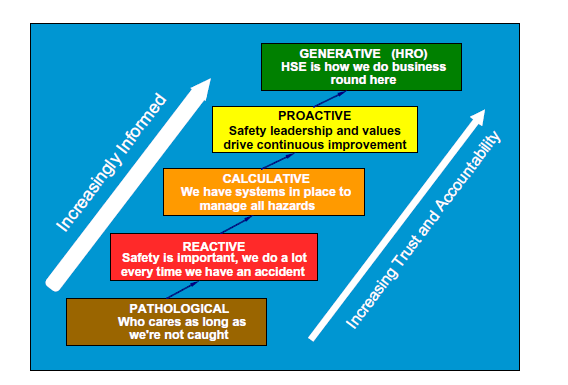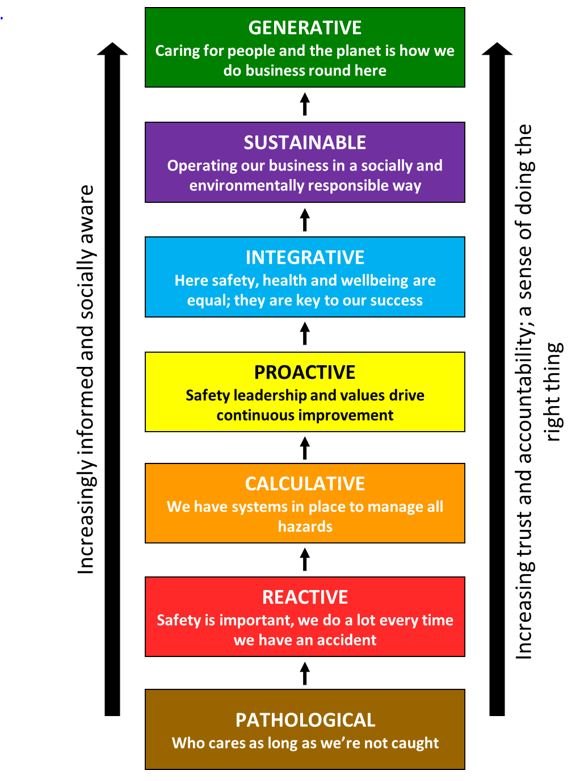The work of one of our leading thinkers, Patrick Hudson, has always fascinated me. I think his work on health, safety and environmental (HSE) culture has been ground-breaking; in particular The HSE Culture Ladder. Its simplicity, user-friendliness and visual nature of describing cultural progression is true genius.
However, recently, I have been musing whether it needs a refresh, a review to reflect our ever-changing world. Perhaps the Ladder needs re-treading?
But first a reminder.
The HSE Culture Ladder
The HSE Culture Ladder (see figure 1 and table 1) has been used worldwide, across a multitude of industries. Described by Hudson (1) as an evolutionary ladder, which plots the development of an organisation’s safety culture, each level has distinct characteristics and is a progression from the previous level. The range runs from the pathological, through to the reactive, to the calculative, on to the proactive and then the final stage of generative. (2).
Professionally, I have used the HSE Culture Ladder concept widely, from the development of culture assessment tools to frontline training. Moreover, whilst the idea of HSE being central to an organisation’s culture – where HSE is ingrained into a business’s DNA – has always had intellectual and practical appeal, I have always found the gap between proactive and generative cultures to be far too wide.
Figure 1 – The HSE Culture Ladder

Table 1 – Descriptions of each level of culture on the HSE Culture Ladder (3)
| Level of the Ladder | Description of culture |
| Pathological | Safety is a problem caused by the workers. The drivers are the business and a desire not to get caught by the regulator. |
| Reactive | Organisations start to take safety seriously, but action is taken only after incidents. |
| Calculative | Safety is driven by management systems, with much collection of data. Safety is still primarily driven by the management and imposed rather than looked for by the workforce. |
| Proactive | With improved performance, the unexpected is a challenge. Workforce involvement starts to move the initiative away from a purely top down approach. |
| Generative | There is active participation at all levels. Safety is perceived to be an inherent part of the business. Organisations are characterised by chronic unease as a counter to complacency. |
Let me introduce you to Integrative…
We have all seen the megatrend toward the equalisation of safety, health and wellbeing. Many organisations are taking their ‘safety cultures’ and transforming them into true ‘safety, health and wellbeing cultures’ (4; 5). They are building on their existing safety frameworks and integrating health and wellbeing into their already established attitudes, behaviours, policies and practices. Consequently, they are treating health and wellbeing as an equal to safety, whereas for so long it has been seen as the poor relation failing to get the attention it deserves (6; 7: 8). But this crucial stage of cultural development is missing from the HSE Culture Ladder. This is why I think a new level, the integrative level, should be introduced.
At this level of cultural maturity, safety, health and wellbeing are together as one; treated as equals, personally and culturally. An organisation is ready to ask what people think about health and wellbeing. Senior management want to understand people’s views. They will invest in cultural surveys designed to garner employees’ perceptions of the organisation’s approach to health and wellbeing risks. They are prepared to extend their business planning process to include objectives to improve psychosocial health. They have included the promotion of mental wellbeing in their communication mechanisms. And, they have encouraged ownership of positive health-related behaviours.
In an integrative organisation, health and wellbeing is not just about placing bowls of fruit in reception, it’s a true cultural phenomenon woven into the fabric of the organisation.
Becoming Sustainable
I think that as organisations journey through the integrative level, they become more socially aware. There is a greater sense of the need to do the right thing. The organisation starts to be more cognisant of the world around them and how their business operations have both a social and environmental impact. I think this is the first stage of an organisation becoming more sustainable.
Whilst sustainability often means different things to different people, and I won’t dwell too much on the definition here, but to a layman (like me!), sustainability is all about operating a business in a socially, economically and environmentally responsible way. At this level the organisation will think beyond its own walls. The organisation starts to consider about how they operate in a different way.
User-friendly frameworks can be used to assess an organisation’s culture and commitment to sustainability. A great example is Bioregional’s One Planet Living Framework (9), comprised of ten principles of sustainability, which provide a holistic approach for organisations to understand how to live within the limits of our planet.
At the sustainable level, it is not just about the pursuit of profit; it’s about working with stakeholders to improve culture and growing business in a responsible manner.
Reframing our understanding of Generative
Hudson elucidated that the key to organisational functioning at the generative level of maturity, is that HSE is ingrained into the organisational culture, which he pithily and eruditely described as: ‘HSE is how we do business around here’. But, personally, I think there is more to achieving this zenith; an organisation has to evolve and transition through the integrative and sustainable levels before going onto becoming generative.
After transitioning through the two additional levels, an organisation genuinely cares about people and the planet, and it grasps the importance of this symbiotic relationship. Because of this, I think being generative exceeds the concept of ‘HSE is how we do business around here’, which means our current understanding needs to be reframed.
I believe central to a generative culture is a climate of caring – emotionally, procedurally and, ultimately, culturally. At this level, the organisation truly cares about its impact upon the world and its people. To me only then can an organisation be truly generative.
The re-treaded HSE Culture Ladder
So, after discussing my musings, here is what I think the re-treaded HSE Culture Ladder looks like…
Figure 2 – The Re-treaded HSE Culture Ladder

References
Reference 1 – Hudson, P.T.W. (2007). Implementing a safety culture in a major multi-national. Safety Science, 45, 697–722.
Reference 7 – Hawkins (1992). The Regulation of occupational health and safety: A socio-legal perspective”. Centre for Socio-Legal Studies, Oxford University.
The Safety Conversation Podcast: Listen now!
The Safety Conversation with SHP (previously the Safety and Health Podcast) aims to bring you the latest news, insights and legislation updates in the form of interviews, discussions and panel debates from leading figures within the profession.
Find us on Apple Podcasts, Spotify and Google Podcasts, subscribe and join the conversation today!



